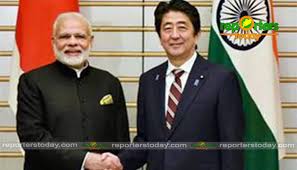
India and Japan signed a $75 billion bilateral currency swap agreement in October 2018.
India and Japan have signed similar agreements in the past as well, but this is the largest bilateral arrangement of this kind in the world.
A bilateral currency swap agreement is an exchange of currencies between two countries
As per this agreement,
- India will be able to borrow in US Dollars or Japanese Yen up to the limit of $75 billion whenever it wants from Japan
- Japan will be able to borrow in US Dollars or Indian Rupees up to the limit of $75 billion from India.
The countries will have to pay interest on the amount actually borrowed.
The repayment will be done at an exchange rate which will be fixed at the time of borrowing. This will eliminate the risk caused due to fluctuations in the exchange rate (also known as FOREX or Foreign exchange risk).
To illustrate- let us suppose India has borrowed $1 from Japan for 2 years. (Say $1 is equal to Rs.70). If the value of rupee decreases at the time of repayment, that is, $1 becomes equivalent to Rs.75, then India will have to repay Rs.75 to Japan. But, if the exchange rate is fixed at the time of borrowing, it will have to repay only Rs.70.
The Indian currency is still overvalued and is expected to depreciate even more, so a fixed exchange rate will be beneficial to India and reduce FOREX risks.
Also, most international transactions are denominated in the US Dollar and the US Dollar has appreciated against most major currencies this year. (The rupee has fallen more than 11 % against the US Dollar.) This has made imports costlier as India has to pay more for goods and services.
Therefore, appreciation of the US Dollar (and the rise in crude oil prices) has put pressure on the current account of India. As per Nomura, India’s Current Account Deficit (CAD) is expected to rise to 2.8 % of GDP in 2018-19.
This agreement will enable India and Japan to trade in their own currencies and reduce the pressure on the current account of India.
The bilateral currency swap agreement will increase India’s foreign exchange (FOREX) reserves as well. India’s FOREX reserves have been declining since the peak of $426.08 billion achieved in April 2018. It is because the RBI has been selling US Dollar reserves to contain rupee depreciation. With the currency swap agreement, India will have an additional $75 billion worth of foreign capital to use whenever required. It will decrease the cost of accessing foreign capital.
It will also decrease speculative pressures on the rupee and provide stability to the foreign exchange rate.
Lastly, it is not very likely that Japan will ask for loans from India as it has huge reserves already.
But, there has to something for Japan as well. The currency swap will boost trade between India and Japan. It has political consequences also. Japan has bought India’s goodwill and will expect its support in international forums.
Japan has signed currency swap agreements with China, Malaysia, Singapore, Indonesia, and Thailand also in the past.
You may also read- Why Rupee hit an all-time low against Dollar?
Updated on 14/4/2020: India is discussing with the US to secure a bilateral currency swap line.
On March 19, 2020, the US opened temporary swap arrangements with the central banks of Australia, Brazil, Denmark, South Korea, Mexico, Norway, New Zealand, Singapore, and Sweden, to be in place for at least six months for a combined $450 billion.
The Fed already has permanent swap arrangements with the Bank of Canada, the Bank of England, the European Central Bank, the Bank of Japan, and the Swiss National Bank.
India offers such bilateral swaps to countries in the SAARC region.
Updated on 31/07/2020: India extended a $400 million currency swap facility to Srilanka under the SAARC framework in July 2020. The bilateral swap request for $1.1 billion is also being considered.
Economyria is now on Telegram. For a simplified analysis of topics related to economy/ business/ finance, subscribe to Economyria on Telegram